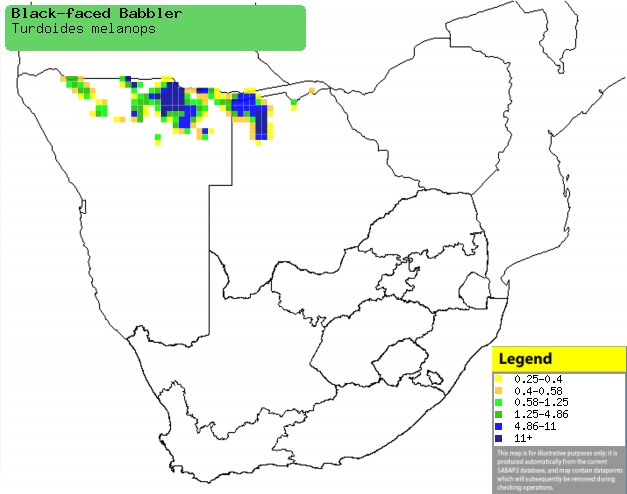|
Turdoides melanops (Black-faced
babbler)
Swartwangkatlagter [Afrikaans]; Siwerewere (generic term
for babbler) [Kwangali]; Letshêganôga [Tswana]; Zwartteugelbabbelaar
[Dutch]; Cratérope masqué [French]; Dunkler droßling,
Schwarzzügeldroßling [German]; Zaragateiro-de-faces-pretas [Portuguese]
Life
> Eukaryotes >
Opisthokonta
> Metazoa (animals) >
Bilateria >
Deuterostomia > Chordata >
Craniata > Vertebrata (vertebrates) > Gnathostomata (jawed
vertebrates) > Teleostomi (teleost fish) > Osteichthyes (bony fish) > Class:
Sarcopterygii (lobe-finned
fish) > Stegocephalia (terrestrial
vertebrates) > Tetrapoda
(four-legged vertebrates) > Reptiliomorpha > Amniota >
Reptilia (reptiles) >
Romeriida > Diapsida > Archosauromorpha > Archosauria >
Dinosauria
(dinosaurs) > Saurischia > Theropoda (bipedal predatory dinosaurs) >
Coelurosauria > Maniraptora > Aves
(birds) >
Order: Passeriformes > Family: Sylviidae
> Genus: Turdoides
Distribution and habitat
Near-endemic to southern Africa, only occurring in northern
Botswana, northern and north-eastern Namibia and south-west Angola. It generally
prefers undergrowth with thickets and creepers in woodland containing Zambezi
teak (Baikiaea plurijuga), corkwood (Commiphora) and Purple pod
terminalia (Terminalia pruinoides), especially when there is a high
canopy and tall patches of grass.
|
 |
|
Distribution of Black-faced babbler in southern Africa,
based on statistical smoothing of the records from first SA Bird Atlas
Project (©
Animal Demography unit, University of
Cape Town; smoothing by Birgit Erni and Francesca Little). Colours range
from dark blue (most common) through to yellow (least common). |
Food
It forages in groups on the ground and in the undergrowth,
eating insects, reptiles and fruit.
Breeding
- Cooperative breeder, living in groups of 4-7, rarely up to 15 birds.
- The nest is a bowl built of grass and lined with finer plant material,
typically placed in the outer branches of a tree.
- Egg-laying season is from October-March.
- It lays 2-3 deep greyish turquoise eggs.
Threats
Not threatened.
References
-
Hockey PAR, Dean WRJ and Ryan PG 2005. Roberts
- Birds of southern Africa, VIIth ed. The Trustees of the John Voelcker
Bird Book Fund, Cape Town.
|
